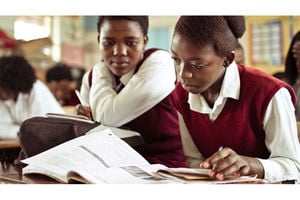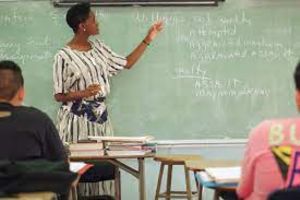
Students of Kakira High School, Jinja, demonstrate their project on making of pavers in June 2024. PHOTO/TAUSI NAKATO
Rolled out in 2020, the new Lower Secondary Curriculum will see its first cohort of learners sit their Senior Four final examinations this October.
Despite the numerous challenges both teachers and learners have suffered during the curriculum implementation, there are already some success stories to write about.
Under the new curriculum, each student is required to complete 24 projects by the end of Senior Four.
Every school under the new curriculum, is supposed to teach 12 subjects at Senior One and Two, of which 11 are compulsory while one is from an elective menu (optional).
Students in Senior Three and Senior Four are supposed to exit with a minimum of eight or maximum of nine subjects, with seven of them compulsory.
The teachers are required to compile the learners’ achievements under the formative assessment in the four-year cycle, find an average score and submit it to the Uganda National Examinations Board (Uneb) to contribute at least 20 percent in the final national exams grading.
Some learners have attained practical skills and certificates to create jobs and employ themselves.
In Moyo District, Mr David Ocen, a teacher in Moyo Secondary School, says the curriculum demands students to have self-esteem.
“The students are encouraged to participate actively and they challenge the teachers which is one of the fundamental aspects of good learning skills to achieve academic excellence,” Mr Ocen says.
Mariam Nuwarinda, a Senior Three student at Kinoni Girls Secondary School in Rwampara District, says she earns on average Shs80,000 monthly from her bakery project at school.
"The students and staff are my customers. Under the new curriculum, we do projects as a group and individuals. So, the bakery one is my project, but I have gained other skills in soap making, knitting and agriculture. I use the earnings for upkeep and buying scholastic materials. I have also learned skills of collaboration since we study and handle some projects in groups."
Elizabeth Namayanja, another Senior Three student at the same school, says by the time she joins Advanced Level, she will be making different garments like dresses, bags, sweaters, socks and mats because of the skills she has so far acquired.
“I plan to start this business after my Senior Four. Through this project, which we do as a group, we have been able to make sweaters, bags and dresses that we sell to the community. I no longer bother my parents for pocket money and I also contribute to my school fees,” Namayanja added.
Sincere Nabimanya Arihereza, a Senior Three student at Bukiro Seed School in Mbarara District, says his dream is to establish a dairy processing factory before completing his education.
“I have already started making yoghurt and I earn at least Shs50,000 a month. I sell my products to fellow students,” he says.
Levi Mwesigwa, also in Senior Three learner in the same school, says since the new curriculum emphasises the use of locally available resources to solve community challenges, it has prompted him to venture into shoe polish making.
“I use charcoal, water, paraffin and dry cells to make shoe polish and I can earn Shs70,000 a month. I have been able to contribute to my school fees. But we also have projects we do in groups where I have earned numerous skills,” he added.

The Permanent Secretary at the Ministry of Tourism, Wildlife and Antiquities, Ms Doreen Katusiime (wearing glasses), and other guests admire items made by students of Kinoni Girls Secondary School in Rwampara District as part of projects done in the new lower secondary school curriculum on June 22. PHOTO/RAJAB MUKOMBOZI
Ms Phionah Kwehangana, the director of Studies at Kinoni Girls Secondary School, says almost every learner can now set up an enterprise and earn a living.
“Here we equip our learners with many skills including agriculture, saloon, bakery, knitting, juice making, crafts making,” she said.
Mr Daniel Mutatiina, the head teacher of Citizen’s SS in Ibanda District, says the new curriculum has “helped students to start up their own workshops and enterprises and if they join tertiary institutions, they already have the basics”.
Shammah Byaruhanga, a Senior Four student at Jinja Secondary School in Jinja City, says he has learnt how to make money in a sustainable manner to combat the effects of climate change.
He says he is part of a Sustainable Development Goal group project where they have to turn waste products affecting the environment into profitable ventures.
Byaruhanga reveals that the group collects papers and plastic materials, which are then used to make door mats and bags, among others.
“Wastes of papers are used to make paper bags in addition to squeezing oil from them that is used as gum,” he told this publication last Wednesday, adding that with the skills attained under this new curriculum, his life will not be the same economically.
He adds: “I can confirm that with these skills, I can be a billionaire in any environment because I turn ‘useless items’ dumped by people into good things bought by others.”
Using the skills obtained, Byaruhanga further boasts of making mosquito repellants using eucalyptus leaves.
He adds that his group earned Shs500,000 in prize money from Stanbic Bank during a competition where his club was ranked fourth in eastern Uganda in the innovation category.
Allen Angela Namuddu,16, recently obtained a certificate in motor vehicle mechanic Level I under the Directorate of Industrial Training (DIT) programme.
She said her new skills in motor vehicle mechanics and the English language are an addition to her experience in working at her family’s spare parts sales outlet managed by her mother, Ms Agnes Nakku, in Kireka, Wakiso District.
“I help in the motor vehicles spare parts sales, fittings and in mechanics work during holidays,” she said.
During her Primary Seven vacation, Namuddu was introduced to the family business by her mother to assist in the car spare parts sales.
With such family training, her choice of motor vehicle mechanics came in handy.
Namuddu joined Hermitage Vocational and Secondary School in Luweero District and expects to her Senior Four final examinations this October at the same school.
She says her choice for a course in motor vehicle mechanics was very surprising to most of her friends at school, especially the girls.
“Many of them [peers] had gone for Fashion Design, Tailoring, Salon Management and Hair dressing courses. I was the only girl who chose a motor vehicles mechanics course,” she says.
In Arua City, Anne Cabrine, a Senior Three student at Cornerstone Secondary School, says she is able to make both liquid and bar soap.
“I have seen even my friends are able to connect electricity, make crafts, which they sell,” she says.
Cabrine says the soap she makes is sold by her parents to buy some scholastic materials.
“The challenge is that the few materials are being shared because even some of the things are still new to the teachers,” she explains.

Senior Two students learn hairdressing at a skills development centre at King James Secondary School, Lira City, in June 2024. PHOTO/BILL OKETCH.
At Fort Portal Secondary School, the head teacher, Mr Regan Katerega, says as a result of the new curriculum the school added lessons in plumbing, electrical, food and nutrition.
Although many schools are making inroads into implementing the new curriculum, others are still struggling. These complain about limited instructional materials, which has forced some teachers to teach learners using the old curriculum because they are unable to access textbooks for the new curriculum. These existing challenges could be the reason why the government recently announced that they had halted the roll out of the Advanced Level curriculum.
The students, who are currently in Senior Four, were supposed to study using the new A’ Level curriculum when they transition to Senior Five next year.
However, the Education minister Janet Museveni says her ministry will not implement the A’ Level curriculum next year as planned. She says the ministry, despite having started reviewing the current A’ Level curriculum, was forced to slow down the pace and instead focus on implementing the already active new Lower Secondary Curriculum.
Mr David Eragu, the head teacher of Dakabela Comprehensive Community School in Soroti District, says: “The new curriculum should have been gradual...in since it is a new concept.”
In Koboko District, Mr Yahaya Atibuni, the deputy Head teacher of Nyarilo Secondary School, says the challenge of inadequate learning materials is hampering the effective implementation of the new curriculum. “We only have two books [the teacher guide and learners guide] against 1,000 or more learners in our school. This is a big challenge,” he says.
Apart from the shortage of learning materials, the school is also facing shortage of classrooms because learners are supposed to study in groups. The Koboko District education officer, Mr Wayi Dagamulayi, says the government has good intentions to change the education system in the country but the funds, learning materials and infrastructure are not enough.
He said in Koboko, which hosts refugees, schools register 125 percent enrollment compared to 100 percent registered and gazetted for planning by the government.
“The curriculum is no longer new because it’s now from Senior One to Senior Four and teachers are skilled. But our challenge is the inadequate instrumental materials. We have an excess of 25 percent who are refugee learners and are not planned for by the government,” he says.
Mr Daniel Kyaterekera Serunjogi, the director of Hermitage Vocational Secondary School in Luweero District, also says some parents are not able to support their children while in school.
“Many of our students enrolled for the different vocational skills…but were never supported by their parents. Some courses require learning material for the projects. Students are also required to register for the Directorate of Industrial Training (DIT) exams, but several failed to register,” he says.
Mr Enoch Kiyemba, the Luweero District senior education officer, says skilling of children should be prioritised at the different levels of learning to instill talent development in children.
“Our children should be guided and encouraged to embrace the different life skilling programmes. The advantage with the skilling programme under DIT is that the award of both national and internationally recognised certificates at the different levels,” he says.
The DIT under the Ministry of Education currently awards certificates for the various disciplines after an assessment undertaken by accredited instructors.
Godfrey Mukisa, a Senior Four student at Masindi Seed Secondary School, says the curriculum is nurturing a generation of innovative thinkers and job creators.
“We are being empowered to dream big and take proactive steps towards achieving our goals,” he says
Grace Apila, another student of Orungo SS in Amuria District, says at her school they are being taught the theory part of the new curriculum with no practical part of it due to a lack of required tools.
“At the end of our O’ Level, the country will expect to have students who are practically able to do craft work, but some of us may fail to meet that expectation,” she says.
Mr Fredrick Ssempala, an education expert says the idea of introducing a new curriculum was good, but government didn’t create an enabling environment for schools to implement it.
“A good curriculum is not about a document as we benchmarked from Europe, but the context, political will and resources to fully translate it from paper into actions,” he noted.
Mr Ssempala added: “I expected the government to boost the funding for this programme, but according to this Financial Year [2024/2025]’s budget no special funding was accorded this programme.”
Differences between the old and new lower secondary school teaching methods
Old Cirriculum
It was competitive in nature and assessment aimed at identifying the best student (s). Teachers were teaching 43 subjects.
New Curriculum
It is accommodative as it provides room for skills development for every learner. Only 12 subjects are taught in Senior One and Two. 11 of which are compulsory while one is from an elective menu (optional).
Students in Senior Three and Senior Four study a maximum of nine subjects, seven of which are compulsory.
•Fine Art was redesigned and is now called Art and Design while History was integrated with Political Education
•Climate change, patriotism, human rights, gender and HIV/Aids were also integrated into the various subjects.
• ICT is used as both an instructional tool for learning and a subject
•Classroom teaching was reduced to five hours a day
• Lessons are supposed to start at 8:30am and end at 2:50pm to allow learners an experiential teacher-supervised learning by engaging in research, project work, clubs and sports.
• The Chinese language was added to the menu of foreign languages while Kiswahili, Physical Education and Entrepreneurship are compulsory for all learners in Senior One to Senior Two.
*Compiled by Al-Mahdi Ssenkabirwa , Dan Wandera, Rajab Mukombozi, Cosline Nakayiira, Felix Ainebyoona, Felix W Okello, Rashul Adidi , Scovin Iceta ,Philip Wafula , Abubaker Kirunda, Denis Edema ,Simon Peter Emwamu & Ismail Bategeka



